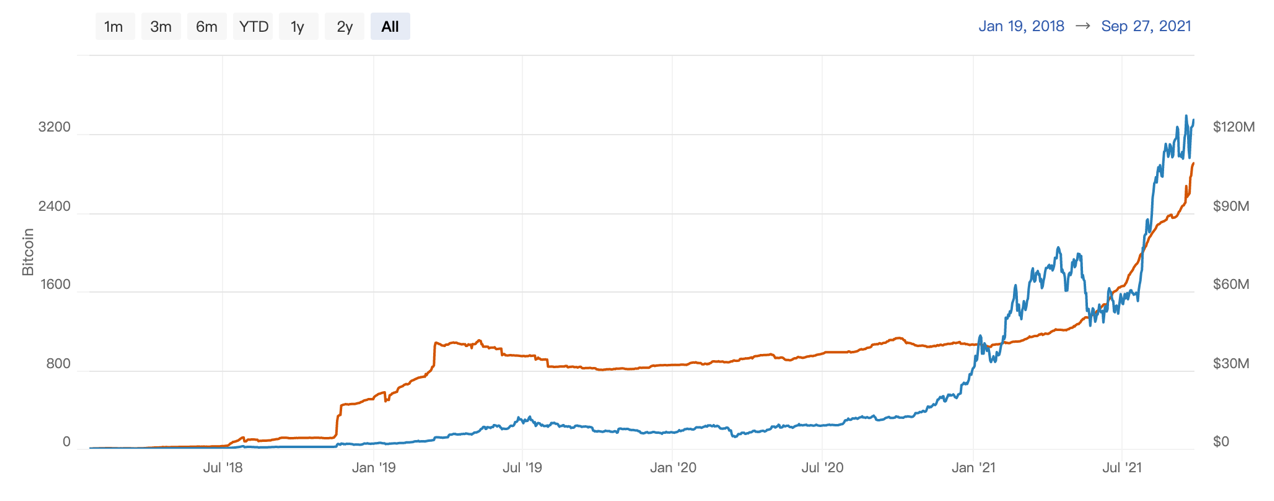After months of testing, Twitter has recently announced the official launch of Tips (a BTC tipping feature) on iOS devices. When an account has turned on Tips, the Tips icon will appear next to the follow button on the profile page. By clicking the button, users can make direct payments through platforms such as Venmo and Cash. BTC tipping has been the most notable new feature in the present round of Twitter update.

Tips is supported by the Strike wallet, which had obtained funding from Twitter's CEO Jack Dorse. This new feature relies on the Bitcoin Lightning Network protocol to support the potentially frequent tipping on Twitter. In addition to the Strike wallet, users can also add the BTC address in their profile, which can be copied by other users for BTC transfers. Twitter has made many attempts to explore crypto technologies. In addition to the launch of Tips, it is also developing other crypto products in fields such as NFT.

The wide adoption of Bitcoin payment is also driven by the increasing public recognition of this cryptocurrency. Apart from Bitcoin payments on Twitter through Tips, the Salvadoran government has adopted Bitcoin as the country’s legal tender. To encourage more citizens to use Bitcoin for payment, El Salvador has even launched a campaign in which citizens can get $30 worth of Bitcoin for free through the government’s Chivo wallet. Moreover, a Salvadoran store equipped with the right facilities for BTC transactions will face punishments if it refuses Bitcoin payments. In this Central American country, many famous non-profit organizations, such as “Bitcoin Beach”, have long adopted Bitcoin as a means of daily exchange. In El Salvador, you can buy a cup of coffee at Starbucks or a burger at McDonald’s using Bitcoin.

Source: Twitter
However, confronted with the huge demand for day-to-day payments, Bitcoin’s slow transaction speed (one block/10 minutes) and small block capacity are clearly insufficient. Therefore, as in the case of Tips on Twitter, the Lightning Network is used for processing the payments of BTC in El Salvador. The Lightning Network, a Layer 2 BTC solution, has become a popular choice for frequent and small BTC payments. Relying on off-chain transactions, the Lightning Network achieves instant transactions, without the usual requirement of block confirmation in the Bitcoin network.
Essentially, the Bitcoin Lightning Network is backed by a scalable micropayment channel network. Through Revocable Sequence Maturity Contract (RSMC), the Lightning Network allows the parties to complete instant two-way transactions on the payment channels predetermined by the Bitcoin network. At the same time, the Network has adopted the Hashed Timelock Contract (HTLC) to facilitate asset transfers between parties who are not connected by a direct peer-to-peer payment channel by creating a route composed of multiple payment channels.
Although the Lightning Network is a mature technology that has been running for a long period, its user base had remained small before. Recently, thanks to its application in scenarios such as daily BTC payments in El Salvador and Twitter’s Tips, the number of Bitcoin channels has surged. In September last year, there were around 38,000 channels in the Bitcoin Lightning Network, whereas the current figure has exceeded 73,000, a nearly twofold growth. That means the Lightning Network has attracted significantly more new users, almost doubling its user base.

Lightning Network Channels (source: bitcoinvisuals)
Not only that, the number of bitcoins locked in the Lightning Network nearly tripled compared with statistics one year ago. At the beginning of September 2020, there were 1,030 bitcoins in the Lightning Network, and now there are approximately 2,900.

Lightning Network Capacity and Price (source: bitcoinvisuals)
It is evident that in the last 12 months, as the Lightning Network technology further improves and upgrades, the application of the Bitcoin Lightning Network has become more extensive. In light of the popularization of Bitcoin, the Lightning Network, a key Layer 2 solution, will be adopted in more scenarios in the future. Meanwhile, the Lightning Network has addressed the problem of slow BTC transactions and freed up more on-chain resources in the BTC mainnet, thereby making it more convenient to engage in BTC micropayments. Thanks to the Lightning Network, Bitcoin is no longer just an investment target, but also a better tool for everyday payment.